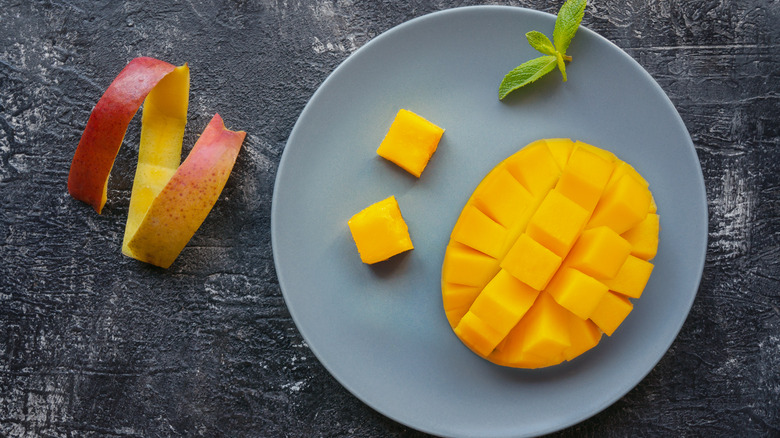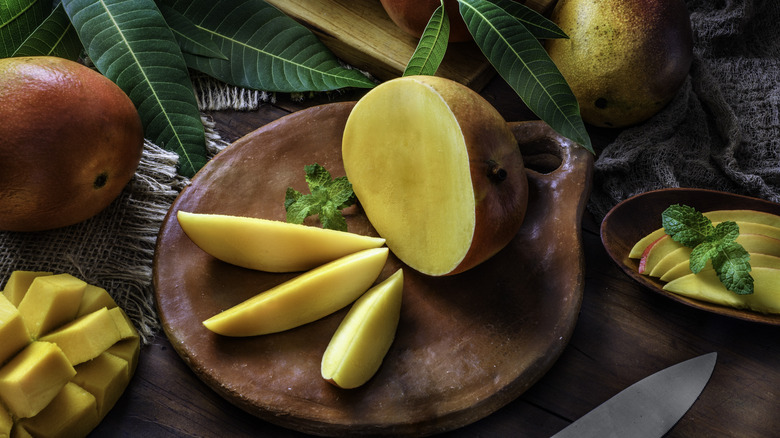You Can Eat Mango Skin, But Here's Why You Shouldn't
There are certain fruits whose nutritious skins can and should be eaten — and others whose rinds are tossed straight in the bin. You wouldn't think twice before biting into, let's say, an apple with its skin on, but eating an unpeeled avocado is, well, unthinkable. But eating the skins of fruits like mango is a more complex matter. While the white pockets inside mangos are safe to eat, is the skin? Mangoes are usually peeled, but the skin, it turns out, is perfectly edible and packed with nutrients. That, however, does not mean that it should be eaten.
Like any fruit, mangoes too are prone to infestation by pests. To combat any damage, mangoes are sprayed with pesticides that may linger on the skin. Eating the skin means that you're likely also eating these pesticides. When consumed in large amounts, the same pesticides can have harmful effects on your health, including poisoning, cancer, and issues related to reproduction (via the World Health Organization).
Then there is the matter of taste. Just because mango skins are edible does not mean that are tasty enough for you to want to eat them. Unlike the golden yellow flesh that bursts with syrupy juice, the skin of a mango has a certain bitterness to it and a leather-like texture that can be tough to chew. Even if you could get past the taste and texture, there's more still to consider before you bite into a mango with its skin on.
Mango skin nutrients have side effects
Mango skins are packed with nutrients, including important antioxidants such as polyphenols, carotenoids, and anthocyanins that can help prevent cancer and heart-related diseases, as a 2007 study published in Food Chemistry indicates. Even better, the skin of a mango has a higher concentration of certain antioxidants than its flesh does — imagine tossing all that away! The skin also has excellent amounts of vitamins E and C as well as a high percentage of dietary fiber. In fact, nearly 45 to 78 percent of mango skin's weight is comprised of nutritious fiber, so why would you not want to eat all of that, you ask? Because it comes with side effects that may far outweigh its benefits.
The harmful effects of pesticides aside, mango skins can also cause allergic reactions. This is because mango skins have the same oily chemical that poison oak and poison ivy do, aka urushiol, which can cause your skin to swell up and leave rashes behind if you are sensitive to it (via Healthline). So, even if you could get past the bitter taste and rubbery texture of mango skin, as well as the small amount of pesticides that may be dotting it, there is a potential allergic reaction to consider. It just isn't worth the hassle to get a few extra nutrients in. A varied diet full of colorful produce is all you need to get the vitamins, minerals, and fiber you need.
If you want to eat mango skin anyway, here's how you can
If you're not allergic to urushiol and decide that you'd like to eat mango skins despite its side effects (it is edible after all), there are plenty of ways to make them more appetizing — just because you can eat the bitter skin as it is doesn't mean that you have to. First, you should get rid of as much pesticide as possible, so you need to be sure you very thoroughly clean the skin before you consume it. You might also want to consider buying organic mangoes if you plan to make it a habit of eating mango skins as these generally have lower amounts of pesticides.
Now that the skins are nice and clean, it's time to season them. Peel off the mango skin, chop it into smaller pieces, and let them crisp up in an oven, an air fryer, or a dehydrator to create chips. Toss the mango skin chips in paprika or spicy seasoning to give it a bit of a zing. You could also cook the skin down to a sweet syrup, blend it into smoothies, lemonades, and fruit marinades, or turn it into a spicy chutney to slather between sandwiches. Cooking and blending it will even take the leathery chew of the skin away, leaving only its nutrients for you to enjoy!



